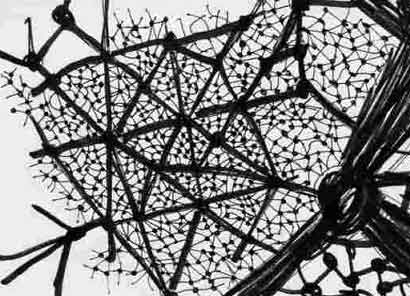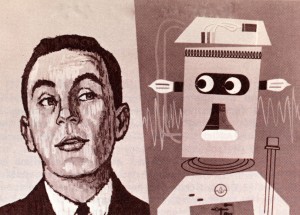Rhizome is a philosophical term used to describe the relations and connectivity of things. The authors Deleuze and Guattari, have assigned this term “rhizome” referring to a relation like that of roots. They spread underground with no direction, no beginning, and no end. They are dispersed. It is opposed to the idea of a tree which has a starting point, and from there branches out in a predictable path. Read More
Rhizome- Deleuze | Guattari
Parametricism – A Method, a Style
Patrick Schumaker – Parametricism A new Global Tyle of Architecture and Urban Design
Schumaker explains his theory on Parametricism as a new style. Based on the notion that a style is recognized as the convergence of research and approach to architecture done by several architects over the las two decades. In saying this, he supports his theory with a set of dogmas that rule over Parametric Style as well as 5 agendas of research. Out of these, what stands out is his ruling out of rigid primitives, the parametric manipulation of geometries, interaction of several systems, complex figurations, project responsiveness, and relationaity in urbanism. He defends the aesthetic quality of projects done by new software and parametric methods as minimal path systems and the like.
As much as I believe that parametricism is a new style, I think the reasons and explanation of this theory by Schumaker is vague and superficial. When compared to work done by other authors as Neil Leach or the origins of parametric in works by D’Arcy Thompson and Deleuze. Schumaker is lacking structure in his theory, a base to support his hypothesis. Examples of this is the fact that he doesn’t give examples in which parameters have been used, how parameters are extracted, what is the process of design, and the role of digital tools and digital fabrication in parametrics.
To complete this theory I would like to mention other texts which support and give body to this structure. In terms of parameter extraction and manipulation to create form, Thompson’s work in “Growth of Form” explains it magnificently. The use of mathematical models and observation to see how a biological being change shape by the modification of parameters explained by the mathematical models. He extract the parameters that control shape and them manipulates them to create new shapes. In addition to parameter extraction, the work by Stephen Johnson in “Emerge”, explores swarms and new ways of object interaction. As a decentralized model where individuals make up the whole, where the part knows only a simple set of behaviors yet put together make the whole work in unison.
In terms of process, the work of Deleuze and Delanda in “Rhizome” and “Deleuze and the Genesis of Form” respectively, clearly point out to a new process or approach. They turn the way of designing from top-down to down-top, making the detail complete the whole. The idea of a basic object or parameter, call it morpheme, replicates and joins itself to create something bigger or modifies parameters to fit to different situations.
As for aesthetics and the role of digital tools and fabrication, Niel Leach and Nicholas Negroponte have a better explanation to how they influence the style. In “Architecture Machines”, Negroponte describes the evolution of machines (also applicable to software) on how they can achieve learning architecture. This evolution let’s use this machines for more detailed designs as well as design inputs and analysis, which in turn gives a richer project and parametric manipulation. Neil Leach in “Fabricating the Future” on the other hand, explains the role of digital tools and fabrication as an aid in the approach to architecture, a new thinking process which involves trial and error as well as deep analysis of parameters. A more precise description of the role of this technologies. Also in this book, Leach counters Schumakers dogmas on primitives and parametric manipulation for figuration by defining the aesthetics of the style not as a result of parameter manipulation and algorithms, but as a negotiation and restriction of the visual opulence of these compositions as an operation that entails elegance.
In general, Shumakers´ text is hiding the lack of information and substantial background examples behind a clever play of words by saying that a style is defined by the common interest of a certain field. His dogmas, as any dogma, is too harsh and doesn’t let the richness of parametrics develop its true potential and value. All in all, in is not a good example of parametricism as a style and can lead to confusion and disregarding of it as such.
It would be interesting to explore and research the nature of the parameters being manipulated in parametricism as well as how the new technologies are being used and what design processes it is bringing forth.
T1- On growth and form – D’Arcy W. Thompson
Part and whole; connections and interactions
FORM – A WHOLE or PARTS?
The topic of debate seem to be whether “forms” (in general) are a result of a general rule (a whole) that contains or parts that mould the whole.
D’Arcy Thompson in his book On Growth and form describes how the form of living organisms have a general mathematical equation of “path” which may be deformed to form variants of the same ”type” due to the action of various external forces. His method also corroborates the parallel existence of different “types“. He also argues that just as the external from is deformed, the internal organs also respond to this general deformation of form. Evidently this suggests an arborescent or top-down system.
While Deleuze and DeLanda thinks otherwise. They assert a bottom-up or rhizome system where each individual (at whatever scale) is capable of altering the whole although the extent may vary and the end result may even be unintentional (as suggested by Steven Johnson in the concept of “emergence”).
It is easy to be step into the deception that the Thompson’s work is in strict contradiction with the rest. However, if we look more deeply we see that he leaves the explanation of “single case” to the existence of rhizomatic properties within a whole and also the interaction of parts with the environment. It is to be noted that his argument about the existence of parallel “types” is in sync with idea of “multiplicity”.
One must argue that if the purpose of “form” at whatever level it may be, is to exist (stabilize) and to thrive (grow) then, there must be a ‘general rule’ just as there is a ‘general purpose’. The “single case” however is definitely an outcome of individual/parts/inputs/data etc. and their interactions integrated into this general form. It is fair to argue that if the interaction between 2 parts have an effect on each of them and if interaction of parts to environment affects the parts, then there should be a counter effect of this on the environment as well. Therefore, the process of form-making becomes more and more specific with the introduction of time as yet another factor of interaction (an example would be evolution). Another simple eg: The purpose of every city is to live and thrive (general rule) depending on its environment (external factors) individuals living within them interact and form settlements, continued interactions over time forms culture, increases demands and slowly other forces* social, economic, political and technology etc. also forms part of the interaction forming rhizomes causing emergence, but all this happens on general whole.
*Forces acting on a whole, DeLanda says looking from this perspective one can even redefine history.
I believe that the idea of “parametics” should be made use of in this sense. Where the architect is the one aware of the general rules and is able to program (taking into account the forces) and work with machines (as suggested by Negroponte in Toward a theory of Architecture machines) to come up with multiple “creative” solutions to the problems of “form” at any level of human existence.
Topic of interest: What is the prevailing “general” form type of a given city. Is it possible to categorize them as tree and rhizome? If the relationship in more complex how can we understand the general growth pattern?
Mark Wigley_The Architecture of Atmosphere
In his writing on Architecture and Atmosphere Mark Wigley is arguing several fundamental to the architectural practice concepts: the importance of atmosphere and what really creates it in a project, architectural representation of atmosphere and how it differs with the diverse design scales: from a city to a building.
The long tradition of architectural theory suggests that architecture is a complex medium, the mere purpose of which is to create a theatrical effect – an atmosphere. It is an intangible collection of particles that surrounds a certain configuration of walls and floors, and is volatile with the addition of a human touch to the building. Wigley’s writing raises several questions: who or what is the creator of an atmosphere: an architect or the inhabitant? Can a complete and fulfilling atmosphere be sole designed by an architect? What is the value of architecture as a design field if an inhabitant contributes as much input to the creation of a given “atmosphere” as does the long months of work of an architect?
Since early works of Frank Lloyd Write “architectural representation” became an expression that goes hand-in-hand with the word “atmosphere”. Several decades ago architects have already understood the importance of showcasing the best parts of the project design and even further enhancing its effects on the surrounding and vice versa, inherently influencing the project’s commission and revenue values. While some rejected the idea of manipulating the representational medium, the majority of designers continued creating idealized images of the pseudo-real projects. Hence, further embedding the value of architectural representation visual “atmospherics” into the monetary equation of architecture as a business. Thus, an atmosphere of a building is no longer a predefined and carefully articulated “soul” of the design, but rather a mere commercialized product produced by “image-making artists”.
Architects and Architecture Machines
The notions of Robotics in architecture put forward in Nicholas Negroponte’s ‘toward a theory of architecture machines’ play with the idea that machines come from an intelligent creator and they “perform well when told exactly how to do something”. As it stands now, machines are used for the monotonous tasks of design, the real design is done by the human. So he puts forward the idea of evolution of machine and relationship between Machine and Designer.
Evolution of Machine :
Nicholas Negroponte talks about a machine that learns by itself. And to explain this he gives forward 5 particular subassemblies as a pert of architecture machine :
- A heuristic mechanism – It is based on thumb ruleswhich drastically limit the search for a solution. Therefore it does not guarantee a solution and look for alternative solutions.
- A rote apparatus – It is a memorizing technique, which after repeated encounter get used to the circumstances and when similar situations are next encountered can give repetitive solutions.
- A continuing device – After repetitive encounters it becomes a habit and each robot gives predefined responses until with little effort.
- A reward solution – A designer observing and evaluating the responses from machine should exhibit his response to direct a machine towards success.
- A forgetting convenience – A machine should be able to unlearn its mistake to continuously evolve and give better and innovative solutions.
Relationship between Machines and Designers :
Negroponte describes a networking system where there is a parent machine(with powerful processor and extensive memory) which is far away from the Designer, but all the architecture machines (Sub-machines) are connected to a parent machine to acquire computing power, stored information and to communicate with other architects and architecture machines.
In the above image Red is Parent Machine, Blue is Architectural Machine and Grey is for Architects.
Negroponte puts forward the dream of having a machine with soul (a true artificial intelligence) that can adapt to task which require more effort than reading scripts and code. The argument then continues on to discuss machines with human characteristics such as sight, he mentions a robot that wanders the city and has opinions of things (a mind of its own).
In my opinion, these notions belong in a sci-fi movie, a thing that is not human will be unlikely to ever be able to carry out tasks beyond those for which it was designed. The subjectivity of human nature is something that no algorithm can replicate in a machine, leave the design to the ‘real’ architect and may the machines make his life easier.
Topic of Research :
I would like to do a research on ‘Use of machine as a tool in evolution of architecture practice’.






